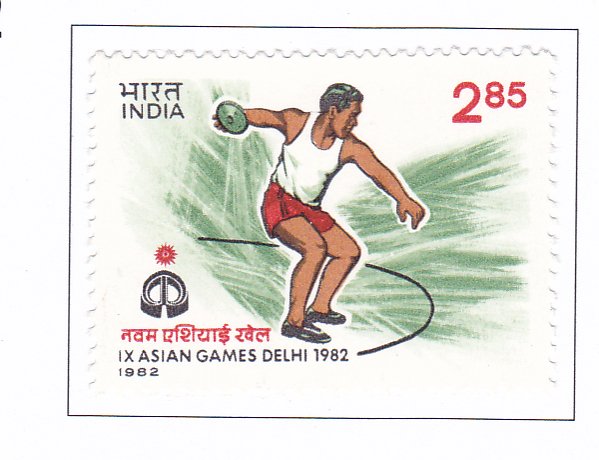Asian Games – Throwing the Discus

Technical Data
| Stamp Set | 9th Asian Games, New Delhi |
|---|---|
| Date of Issue | November 19, 1982 |
| Denomination | Rs. 2.85 |
| Quantity | 3,000,000 |
| Perforation | comb 13¼ x 13 |
| Printer | Security Printing Press, Nashik |
| Watermark | No Watermark |
| Colors | Multicolor |
| Catalog Codes |
Michel IN 928 Stamp Number IN 1000 Yvert et Tellier IN 739 Stanley Gibbons IN 1063 |
| Themes | Discus-throwing | Sports |
The IX Asian Games in 1982 epitomized the highest virtues of humanity, reflecting the admirable qualities brought to perfection in sports. Sports are a testament to human endeavor, constantly pushing the boundaries of achievement. This philosophy dates back to the ancient Greeks, who founded the Olympics to highlight the potential of organized sports beyond individual exercises. The Olympic year also symbolized peace and goodwill, marked by a general truce among the warring Greek city-states.
Significance of the Asiad
The Asiad symbolizes Asian unity, fostering fraternity and friendship among nations while reinforcing old bonds. Despite numerous challenges and failed attempts to organize such games in Asia, the Asian Games were successfully established under the patronage of Jawaharlal Nehru, an advocate of peace and brotherhood. The Asian Games have since sparked a renaissance of sports across the continent.
Growth and Participation
The inaugural Asiad in 1951 saw participation from eleven countries with small contingents. In contrast, the IX Asiad witnessed participation from three times as many countries, with over 500 athletes competing in 21 events, including new additions such as equestrian, handball, golf, and rowing.
Transformation of Delhi
Delhi underwent a remarkable transformation in preparation for the games. The city, adorned with new patterns and designs, featured numerous new flyovers, towering hotels, and the well-planned Asiad Village, creating a welcoming environment for international guests. Key sports venues were renovated, and new ones like the Jawaharlal Nehru Stadium with synthetic tracks and the Indraprastha Indoor Stadium with its silvery dome were constructed, showcasing exquisite architectural and functional design.
Celebration and Global Attention
As the IX Asiad commenced with grand pageantry, color, and jubilation, the world turned its gaze to Delhi. Appu, the playful and friendly mascot, extended a warm welcome to all participants, embodying the spirit of the games. The Indian Posts and Telegraphs Department commemorated the opening day by issuing a set of four stamps, celebrating the significance and excitement of the event.
Conclusion
The IX Asian Games were more than a celebration of sports; they were a testament to unity and peace among Asian nations. The event marked a significant milestone in the history of sports in Asia, emphasizing the importance of fostering friendly competition and camaraderie among countries. The extensive preparations and successful execution of the IX Asiad reflected India’s commitment to promoting sports and international goodwill, leaving a lasting legacy for future generations.
